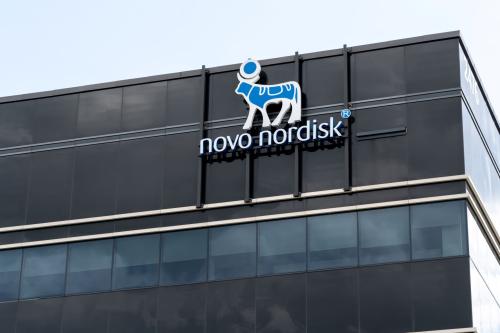This analysis is part of the USC-Brookings Schaeffer Initiative for Health Policy, which is a partnership between Economic Studies at Brookings and the University of Southern California Schaeffer Center for Health Policy & Economics. The Initiative aims to inform the national health care debate with rigorous, evidence-based analysis leading to practical recommendations using the collaborative strengths of USC and Brookings. This piece originally appeared in Fast Company on October 28, 2021.
At the end of May, tennis star Naomi Osaka withdrew from the French Open citing anxiety and depression. A few months later Simone Biles missed a significant portion of the Olympics for reasons related to her own mental health. These cases and others have drawn much-needed attention to the toll mental health conditions exact—for employees and employers—in workplaces that go well beyond high-profile athletics to warehouses, offices, and shop floors.
The evidence is clear that the cost of mental illness in the workplace is significant and widespread, and that it accumulates over a worker’s lifetime. Almost 20% of working adults report significant symptoms of mental illness over the course of a month, and half will experience an issue over their lifetime. Think about that for a moment. That potentially means one in five of your employees could be struggling with significant mental health issues as you read this.
While illnesses vary in severity and nature, symptoms can interfere with productivity in ways that have meaningful consequences for employers and employees alike. Depression, for example, can make small tasks seem daunting and can lead people to be irritable and angry with others. Anxiety can make it hard for people to meet deadlines, participate in meetings, or make presentations. Experiencing symptoms of mental illness can lead people to miss work altogether. In some cases, mental illness symptoms lead people to lose or leave their jobs.
If employers want a future of work where business continues to grow and thrive, then we need responses that recognize the reality of mental health symptoms, allow for flexibility and accommodation in work, and still preserve productivity.
The good news is that such solutions exist. The disruptions caused by mental illnesses at work can themselves be interrupted, by combining high-quality clinical interventions with workplace accommodations and support. And changes in the workplace brought on by the COVID-19 pandemic offer new opportunities to put those solutions in place.
For example, the rapid expansion of tele-mental health during the pandemic can make it easier to facilitate access to treatment for workers by reducing the time and travel costs of care. Also, after a year and a half of practice, many firms and workers have become more comfortable with remote work using Zoom meetings, text rather than verbal communications threads, and alternative work schedules. Just as closed captioning and text readers have made it easier for people with hearing and visual impairments to participate in the workforce, the technologies that facilitate remote work and care may offer workers with mental illnesses more opportunities to remain healthy and engaged in work.
These interventions can help the workforce of today and the workforce of 2040 as well. The first symptoms of mental illnesses frequently appear in young adulthood, disrupting career paths and making it more difficult to gain the experience and cognitive and interpersonal skills that establish a platform for success. People experiencing mental health conditions may be channeled toward jobs with skills that pay less and are more vulnerable to foreign competition and automation. That’s a loss of human potential that accumulates over time and leaves people who have experienced mental illness in the past with lower wages, lower savings, fewer assets, and a higher likelihood of reliance on public assistance. The result is a wasteful spiral of lost human talent, workplace investments, and economic productivity.
Treatment and accommodations alongside new technologies may help young workers with mental illnesses gain expertise and expand the range of jobs that are available to them.
Making workplaces and jobs more flexible in time, space, and nature of interaction will be of immediate benefit to people with mental illnesses. It’s also likely to produce benefits well beyond concerns with mental illness.
Accommodations that help people with mental illness can also address the full range of factors that complicate and disrupt people’s lives and affect their work—that is, just about everyone. This “curb-cut effect” was named after the unexpected benefits that arose from those indentations in sidewalks (curb cuts). Originally aimed at expanding wheelchair access to sidewalks, they turned out to have many beneficiaries—from parents pushing baby strollers to tourists pulling rolling suitcases. Similarly, greater workplace flexibility and support can benefit vast numbers of workers and their employers.
Most important, these technologies have the potential to be transformational for workers experiencing mental illnesses today and well into the future. If more employers embrace the treatments and accommodations that have been shown to work along with innovations coming out of the pandemic, we can create a future of work that is more equitable and economically vibrant for individuals with mental illnesses and the companies that employ them.
Sherry Glied is on the board of Geisinger. The authors did not receive financial support from any firm or person for this article or from any firm or person with a financial or political interest in this article. Other than the aforementioned, they are currently not an officer, director, or board member of any organization with an interest in this article.
The Brookings Institution is financed through the support of a diverse array of foundations, corporations, governments, individuals, as well as an endowment. A list of donors can be found in our annual reports published online here. The findings, interpretations, and conclusions in this report are solely those of its author(s) and are not influenced by any donation.





Commentary
Making workplaces better for people struggling with mental health will make work better for everyone
November 1, 2021